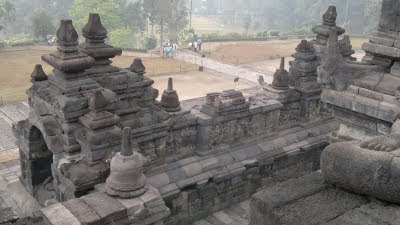10 juillet, je quitte Probolinggo au niveau de la mer et me dirige vers le volcan Bromo. La route est plate sur une vingtaine de kilomètres puis c’est la montée qui commence. Ça monte dur, très dur, il y a des pentes de folie. Il me faut au final 9 heures pour parcourir moins de 50 kilomètres et arriver au village de Cemoro Lawang, à environ 2300 mètres d’altitude, au bord d'un cratère d’une dizaine de kilomètres de diamètre (le Tengger). Quelle journée ! Je prends une chambre et me dirige au bord du cratère pour admirer le spectacle. Devant moi, en contrebas, une mer de cendres et sable volcaniques (la Laotian Pasir), à droite le cratère du Batok, à gauche le cratère fumant du Bromo. Quel spectacle ! Je suis récompensé de mes efforts de la journée.
11 juillet, lever à 3h30, départ à pied à 3h45, il fait bien sûr nuit noire mais il ne fait pas trop froid. Je monte au sommet Penanjakan (2770 m), j'y arrive à 5h15. Le lever du soleil est à 5h30, des dizaines d’autres visiteurs sont là pour assister au spectacle d’une très grande beauté qui s’offre à nous. Vers 6h15 j’entame le retour à l’hôtel.
Pour éviter de revenir vers l’est, je dois traverser la plaine de sable/cendres. Avec le vélo chargé, je ne suis pas sûr d’y parvenir. Certaines personnes me disent que c’est possible, d’autres me disent que non. Je trouve un chauffeur qui accepte de venir me retrouver et me transporter si j’ai besoin, je prends son numéro de téléphone et part à l’aventure seul. Une petite traversée de la mer de sable me conduit au pied du Bromo. J’effectue l’ascension à pied, l’ambiance est absolument irréelle. Arrivé en bordure de cratère, on peut entendre le grondement au fond du volcan mais la visibilité est nulle vers l'intérieur à cause des nuages de cendres. Je redescends vers mon vélo et attaque la traversée de la mer de sable sur une dizaine de kilomètres, ça avance finalement mieux que je ne l’aurais imaginé. Il me faut ensuite remonter en bordure du grand cratère (difficile car le montée est très raide). Il ne me reste maintenant plus qu’à descendre et descendre encore sur des kilomètres, ce n’est toutefois pas de tout repos car sur les premiers kilomètres, la route n'est pas en bon état.
J'arrive à Malang et prends une confortable chambre d’hôtel.
10th of July, I leave Probolinggo, which is at sea level, and ride towards the Bromo volcano. The road is flat for about 20 kilometres and then it starts to go up. The road is steep, very steep. I takes me about 9 hours to cover less than 50 kilometres and arrive in the village of Cemoro Lawang, about 2300 meters above sea level, on the edge of the Tengger crater, which has a diameter of about 10 kilometres. What a day! I take a hotel room and walk to the edge of the crater to admire the spectacle. In front of me, below, a sea of volcanic ashes and sand (the Laotian Pasir), on the right the Batok crater, on the left the smoking crater of the Bromo. What a sight! I am rewarded for my efforts of the day.
11th of July, I wake up at 3.30 and start walking at 3.45, it is still dark of course but it is not too cold. I climb the edge of the large crater to reach Penanjakan (2770 m), I arrive there at 5.15. The sunrise is at 5.30, dozens of other visitors are there to view the magnificent spectacle that is in front of us. Around 6.15, I go down back to the hotel for a hearty breakfast.
To avoid going back to the east, I must cross the sand/ashes plain. With the pike loaded, I am not sure I can do it. Some people tell me it is possible, some say it is not. I find a driver who accept to find me and transport me if I need, I take his phone number and start the adventure alone. A small crossing of the sand sea leads me at the foot of the Bromo. I start to climb the crater on foot, the atmosphere is just unreal. When I arrive on the edge of the crater, I can hear the roar at the bottom of the volcano but there is no visibility on the inside because of the clouds of ashes. I go down back to my bicycle and start the crossing of the sand sea which is about 10 kilometres, it is finally easier than I expected. I then have to go up from the inside of the large crater to the edge (difficult because steep). Now, I start a very long ride down, this is not easy though because in the first kilometres, the road is not in good condition.
I arrive in Malang and take a comfortable hotel room.

Le Bromo et la Batok.
The Bromo and the Batok.

Vue du village de Cemoro Lewang (en bordure du grand cratère) depuis le sommet Penanjakan au lever du soleil.
View of the village of Cemoro Lewang (on the edge of the large crater) from the Penanjakan at sunrise.

Vue du Batok, du Bromo (fumant) et d’un troisième volcan au loin.
View of the Batok, the Bromo (smoking) and of a third volcano in the distance.

Le Bromo.
The Bromo.

Vue depuis le Bromo.
View from the Bromo.

Au bord du cratère du Bromo.
On the edge of the crater of the Bromo.

Prêt pour la traversée de la mer de sable/cendres.
Ready to cross the sea of sand/ashes.































